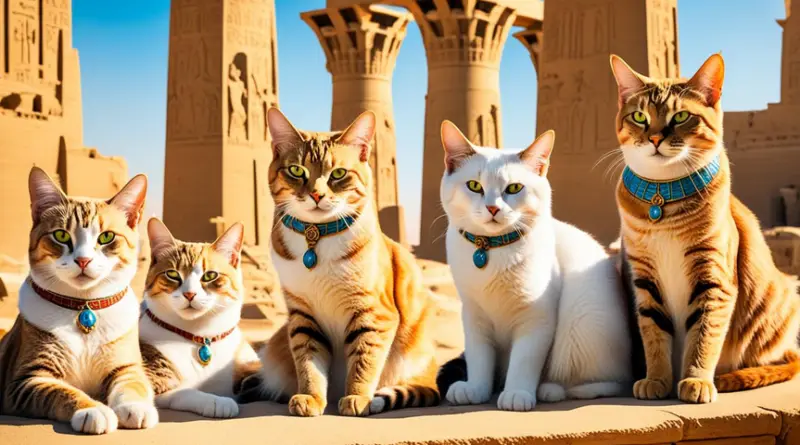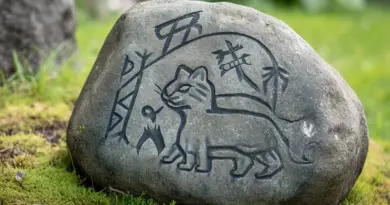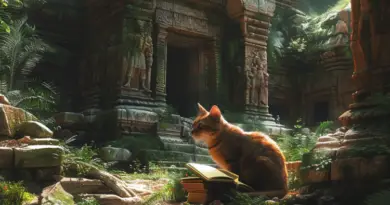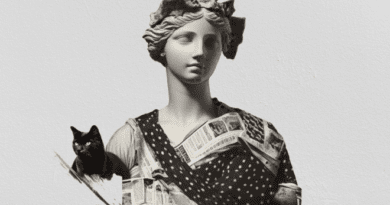Cats in Ancient Egypt
In ancient Egypt, people regarded cats as sacred, a fascination that continues today. This article explores the veneration of cats and their significant influence on Egyptian culture and society. We’ll examine how cats shaped ancient Egyptian life and left a lasting legacy.
Egyptian goddesses like Bastet, known for her powerful presence, held immense importance and devotion. We’ll delve into their connections with Egyptians and their beloved cats, exploring how these feline deities influenced Egyptian beliefs and practices.
Next, we’ll discuss the domestication of cats in ancient Egypt and their vital societal roles. Archaeological evidence and historical accounts will highlight their importance. We’ll also cover the significance of cat mummies and their special burials, demonstrating the high value Egyptians placed on their feline companions.
Finally, we’ll explore how cats appear in ancient Egyptian art and iconography. We’ll analyze their representation in art and architecture and trace the influence of feline worship on later cultures and religions. This comprehensive look will reveal the profound impact cats had on ancient Egypt.
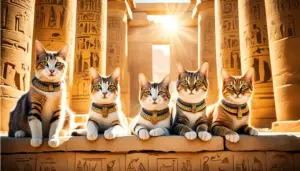
Key Takeaways
- Cats were sacred in ancient Egyptian culture, with deities like Bastet getting a lot of devotion.
- Feline deities were important in Egyptian mythology, symbolizing many things.
- Domestic cats were very important in ancient Egyptian society, as shown by archaeological finds.
- The Egyptians treated their cats with great respect, as seen in their burial practices and cat mummies.
- Cats were everywhere in ancient Egyptian art, architecture, and symbols, showing their deep worship.
Introduction to Cats in Ancient Egyptian Culture
Cats held significant importance in ancient Egyptian society. Egyptians first domesticated cats, later elevating them to divine status. Their influence on Egyptian history and artifacts is profound.
In ancient Egypt, cats were not merely pets; they were revered as gods. These felines played a crucial role in Egyptian beliefs and rituals. Many were mummified and buried with great honor.
Cats were closely associated with deities like Bastet, the cat-headed goddess of fertility, protection, and the home. Ancient Egyptian art frequently depicted cats, from iconic sphinxes to intricate hieroglyphics on temple walls. Egyptians believed cats possessed magical powers and served as protectors in the afterlife, guiding the deceased on their journey.
The deep connection between cats and ancient Egyptian culture is undeniable. Their religious, societal, and artistic significance continues to captivate historians and enthusiasts alike, highlighting the lasting impact of these remarkable animals on this ancient civilization.
The Cult of the Cat Goddess Bastet
In ancient Egypt, the goddess Bastet was a standout figure. She became very popular over time. People saw her as a powerful cat goddess linked to fertility, protection, and the sun.
The Rise of Bastet’s Popularity
Bastet’s fame started in the city of Bubastis, where her main temple was. Her cult grew, making her a top goddess worshipped by many. People from all walks of life adored her. Her link to the sun made her even more powerful in the eyes of the Egyptians.
Bastet’s Feline Aspects and Symbolism
Bastet’s cat-like features played a crucial role in her depiction in ancient Egyptian art and architecture. Artists frequently portrayed her with the head of a cat or lioness, emphasizing her dual role as a nurturing protector and fierce guardian. These feline characteristics appeared prominently in various Egyptian artifacts and structures.
Ancient Egyptian art and architecture vividly illustrate the profound affection Egyptians had for cats. Bastet and other cat deities frequently appeared in these artworks, highlighting the significant role of cats in daily life and religious practices. This cat iconography underscores the deep connection between Egyptian goddesses and the ancient Egyptians’ everyday experiences.
Cats in Ancient Egyptian Mythology
In ancient Egypt, cats were more than just pets. They were a big part of the mythology. Gods like Bastet, Sekhmet, and Mafdet were important. They stood for power, protection, and the cycle of life.
The Roles and Significance of Feline Deities
Bastet, a prominent cat goddess, was revered for her protection of people. She was often depicted as a woman with a cat’s head or as a cat, symbolizing grace, fertility, and nurturing qualities.
Sekhmet, another key deity, was known for her lioness head. She represented war, healing, and the sun. Mafdet, though less known, played a crucial role in guarding against venomous creatures and upholding justice.
Bastet: Goddess of protection, fertility, and cats
Sekhmet: Goddess of warfare, medicine, and the sun
Mafdet: Protector against venomous creatures and guardian of justice
These cat deities were central to ancient Egyptian culture, deeply intertwined with beliefs, rituals, and daily life. Cats and their associated myths were essential to Egypt’s cultural and religious identity.
“In ancient Egypt, the cat was more than a domestic pet; it symbolized divinity and represented the gods themselves.”
Sacred Cats and Their Protection
In ancient Egypt, people revered cats as sacred animals and considered their well-being essential. Cats were not just pets; they held significant cultural and religious importance. Archaeologists have uncovered large cat cemeteries that illustrate this respect.
Egyptians believed cats possessed a divine essence and associated them with the goddess Bastet. They mummified and buried cats with great care, reflecting their belief in honoring these animals even after death.
The largest cat cemetery was discovered in Bubastis, the city dedicated to the goddess Bastet. This site contained thousands of cat mummies, demonstrating the Egyptians’ deep affection for their feline companions. Smaller cemeteries, found in locations like Saqqara, further reveal how highly Egyptians valued cats throughout their civilization.
The mummification process involved dressing cats in jewelry and amulets, underscoring the significance of their afterlife. These sacred cat cemeteries offer valuable insights into the profound role cats played in ancient Egyptian society and highlight the enduring impact of their veneration.
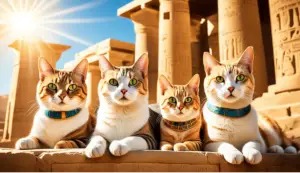
“Cats were so revered in ancient Egypt that the penalty for killing a cat, even accidentally, was death.”
Domestication of Cats in Ancient Egypt
Cats became very important in ancient Egypt. Archaeologists found cat remains and artwork that shows they were more than pets. They helped with pests and were seen as sacred.
Archaeological Evidence of Domesticated Felines
Archaeologists found many cat remains in Egypt. These include mummies and burials. This shows us how cats were first domesticated around 3700 BCE.
The Pivotal Role of Cats in Egyptian Society
Cats were highly respected in Egypt. They helped keep rodents away from grain, which was crucial.
They were also linked to the goddess Bastet, who was seen as protective.
The domestication of cats in ancient Egypt changed society. As cats in ancient Egypt became more common, they became even more loved and sacred.
| Archaeological Evidence |
Significance in Egyptian Society |
|
• Mummified cat remains
• Cat burials
• Depictions of cats in artwork |
• Pest control and protection of grain supplies
• Association with the goddess Bastet
• Revered status as beloved companions and sacred symbols |
Cat Mummies and Burials
The ancient Egyptians held cats in high regard, as evidenced by their practice of mummifying and burying them in dedicated cat cemeteries. Archaeological finds from sites like Saqqara, Abydos, and Beni Hassan reveal extensive cat cemeteries. The Egyptians carefully mummified their cats, using detailed wrappings and adornments to preserve the bodies. They placed these mummies in special sarcophagi or chambers.
These discoveries highlight the deep respect the Egyptians had for cats, viewing them as sacred animals linked to the goddess Bastet. Egyptians believed cats possessed divine powers, treating them with the same reverence they showed humans in the mummification and burial process.
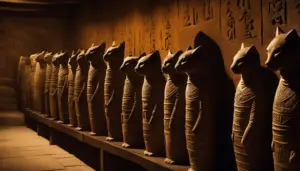
Archaeologists also found big graves with many cat mummies. These graves show the Egyptians might have had big cat cemeteries. They buried many cats together.
The detailed cat mummies give us a lot of information. They tell us about the Egyptians’ bond with cats. They show how they mummified cats and what cats meant to them culturally and religiously.
Cats in Ancient Egyptian Art and Iconography
Cats were a big part of ancient Egypt’s art, appearing in many forms. They were shown in statues and wall carvings, showing how much people respected them. These cats were more than pets; they were important in the culture.
Feline Motifs in Sculpture, Painting, and Architecture
The ancient Egyptians loved to include cats in their art. They made statues like the famous bronze figure of Bastet, showing how much they valued cats. Paintings in temples and tombs often had cats, showing their high status.
They even put cat shapes in buildings, like columns and decorations. This art showed how much cats meant to them. It also helped keep the memory of cats alive in Egyptian culture.
“Cats were revered in ancient Egypt, and their images were ubiquitous in the art and architecture of the time. From the majestic statues of Bastet to the intricate carvings on temple walls, the cat was a central figure in the artistic expression of the Egyptians.”
The many cat images in ancient Egyptian art show how important cats were. They were not just pets but a big part of the culture and beliefs. Their art made sure the cat’s story lived on for many years.
The Legacy of Feline Veneration in Ancient Egypt
Cats have always held a special place in human culture and religion. Ancient Egyptians, for example, worshipped cats under the powerful goddess Bastet, showcasing their fascination with these enigmatic creatures.
Today, the influence of Egyptian cat worship remains evident. We still see it in the cat-headed deities of Mesopotamia and the cat mummies discovered in the Mediterranean. Cats continue to captivate our imagination in art, literature, and culture.
The Egyptians admired cats for their grace and agility, believing they had divine connections. This reverence has endured, shaping our modern perception and treatment of cats. The legacy of ancient Egyptian cat worship continues to inspire and remind us of the profound bond between humans and cats.

